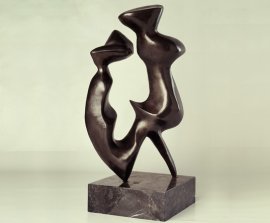
Art has one purpose; and that is to discipline the soul. Paul Valéry
Ali Akay, 1998
Günnur Özsoy is an artist whom we can think of as trying to capture the spirit of motion, by losing herself within the fluidity of that same motion, all the while trying to control its velocity and direction; in her sculptures she almost resigns to the contingency brought about by motion. While trying to reduce the impact of the shape plastically and trying to govern the experimental and coincidental aspects of the emerging shape, she attempts not to ignore the theme that is actually at stake in her mind: Woman and the movement of her body. Instead of the sexuality of figures, which are entangled with each other and are ambiguous as to their gender, she attempts to present a border that originates from the indeterminacy of the forms; the sculptures which struggle to bring together the artistic spirit of motion and the meaning of shape within these borders, present figures which makes us ask how they were shaped, rather than question how they were made. The forms which are depicted as figures represent, for her, something more interesting than how they were made. Perhaps in this way, Günnur Özsoy investigates how the art of the soul is made. One of the purposes of art is that art is a purpose for itself. Figures which gain independence from all kinds of narratives and references, can sometimes become the purpose of art. This isn't only to put the soul into preparation; it is, simultaneously, meaningless unless this soul becomes a work and questions what the work is. The purpose of the artist then becomes to capture the soul in an instance where governing the technique is extremely difficult and the shape represents nothing but indeterminacy, and then try to shape that soul. This shape can manifest the materialization of soul and mind simultaneously, at the instant where indeterminacy gains foothold and the shape comes to be. Then, this shape turns into a beautiful body. We are faced with bodies which do not yet have a gender, but which gives an impression of femininity. At times they are entangled with each other, at other times they give us a movement which is enlarged as is the phallus of the god of fertility. Reminding us of sacrificial rituals and votive offerings to Dionisian gods, orgiastic figures appear from a medium of indeterminacy. Günnur Özsoy, who admits that she can only work at these dimensions with this technique, present us bodies which have folds made by the motion of concave forms. In this way, the work itself obtains for itself some kind of soul: it gains corporeality. This corporeality represents a ceremony of passage from the most extreme indeterminacy to the most distinct figure. This ceremony, however, does not bring about any forms other than the ones that the sculptures obtain contingently in a playful manner: as the sculptures of Günnur Özsoy, who has adopted an experimental method, start to take on forms from indeterminacy, as the artist determines the mental structure that she designed, she can bring about forms which do not look real and do not give a feeling of completeness at all.She also names some of the forms that she creates while materializing souls: Dracula, for instance, is one of those figures. Günnur Özsoy also gives a steady self-rotational motion to her sculptures. Another figure is entitled "Şebnem Hanım'ın Bacağı" (Şebnem Hanım's Leg): This constrasts as a figure belonging to our own country, as opposed to the Romanian Dracula. Often the figures become so personal that they can revolt against the dictates of the artist: The Dracula figure resists to be put on a pedestal. The vampire which does not reflect its figure on a mirror, also does not want the pedestal for its' sculpted form.